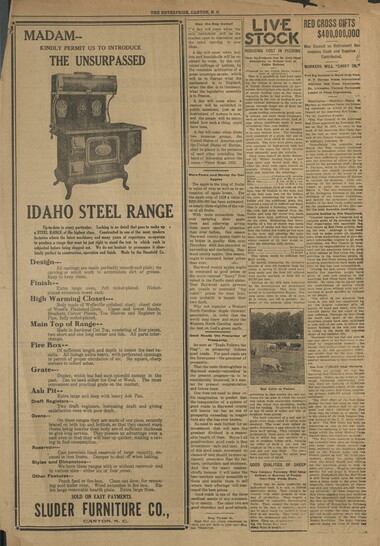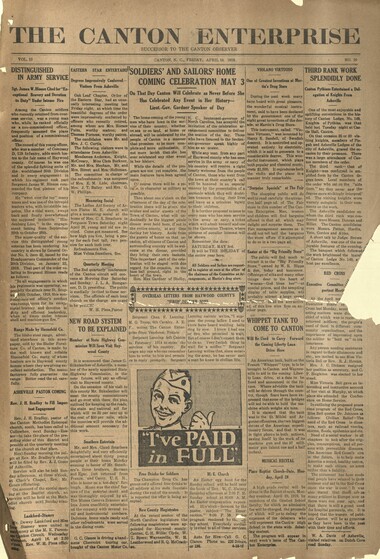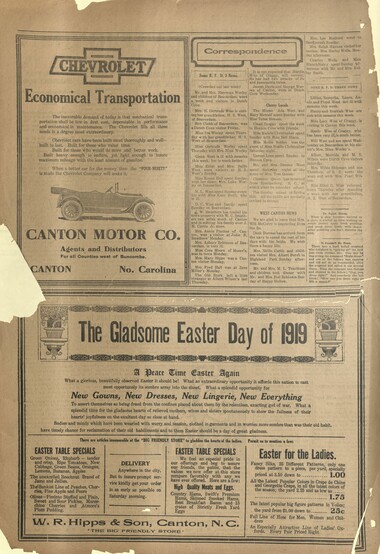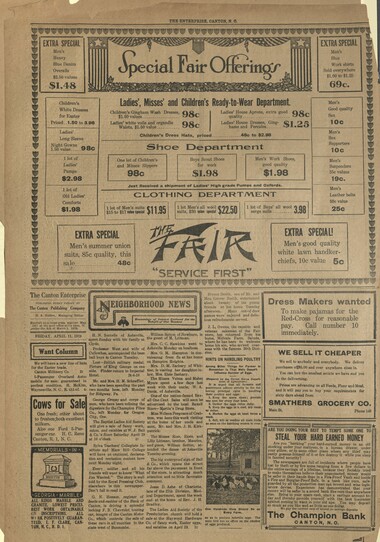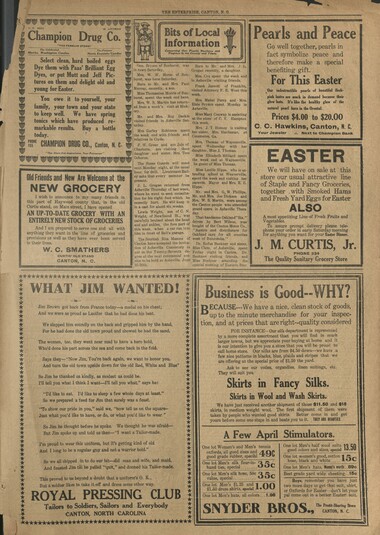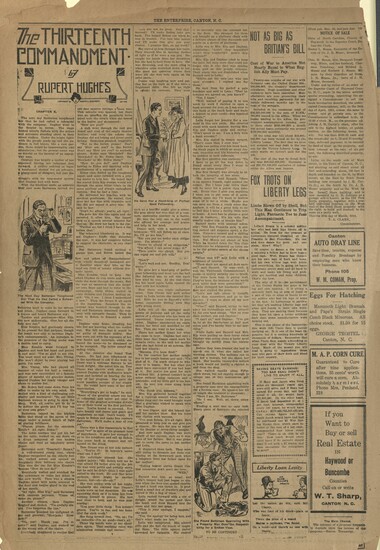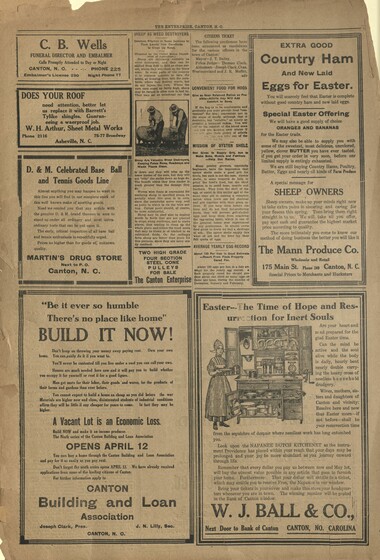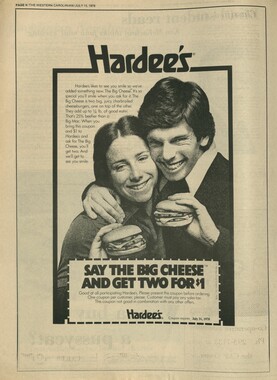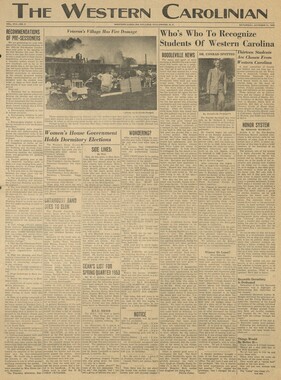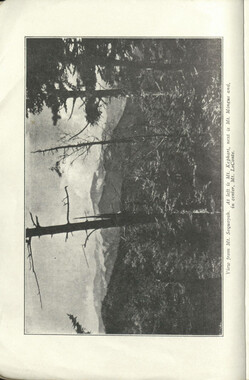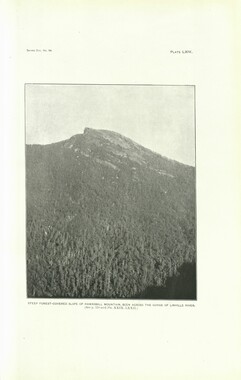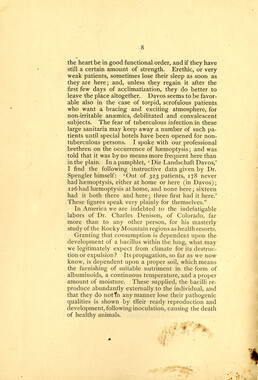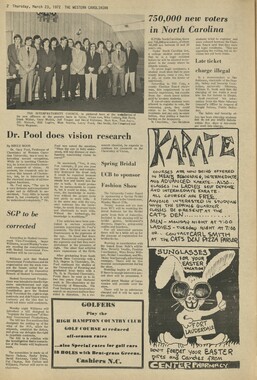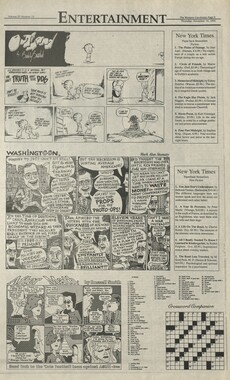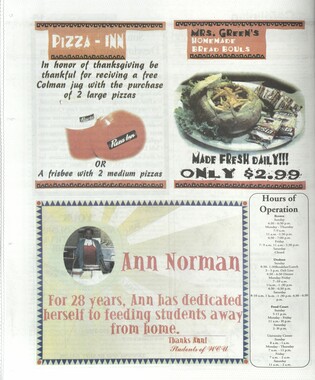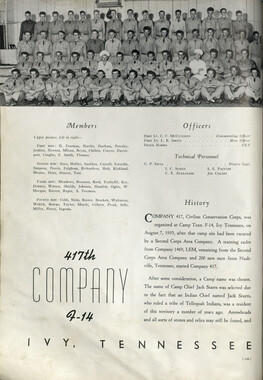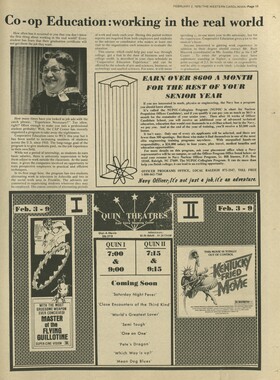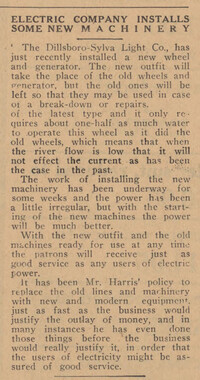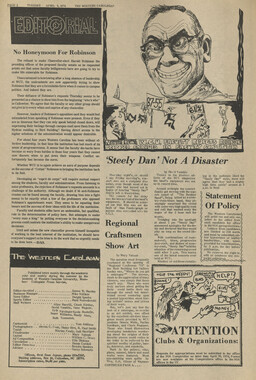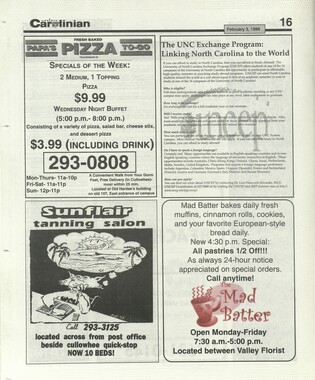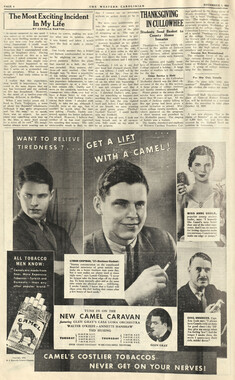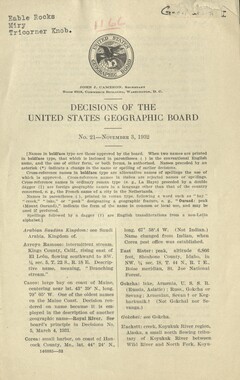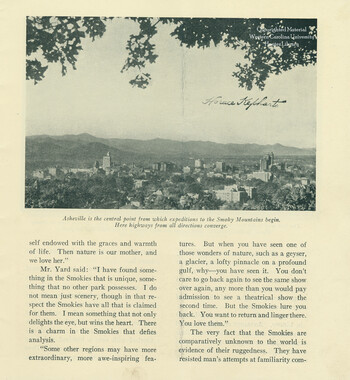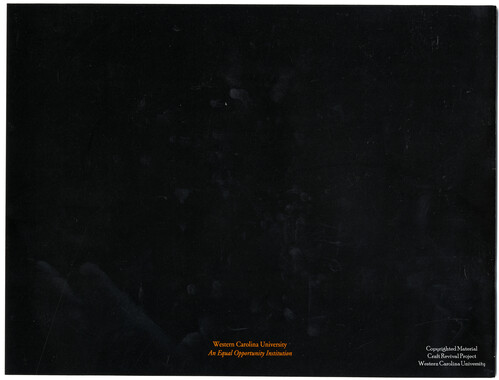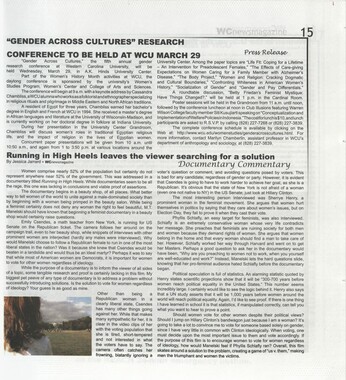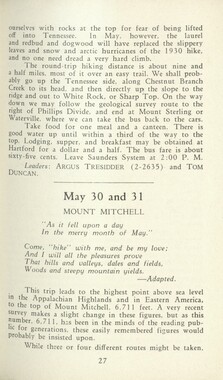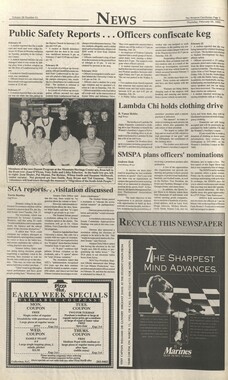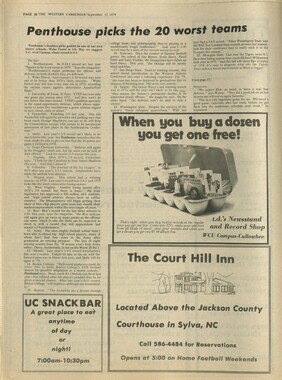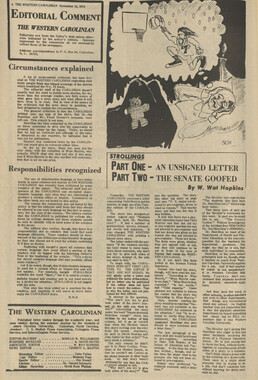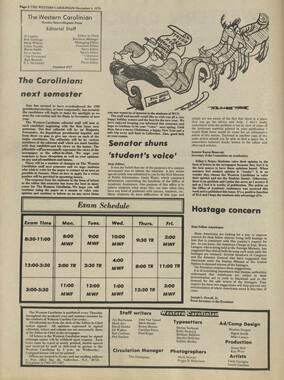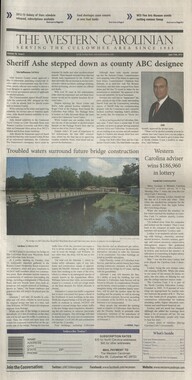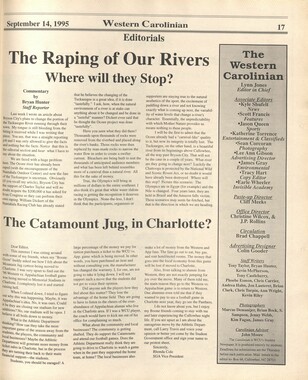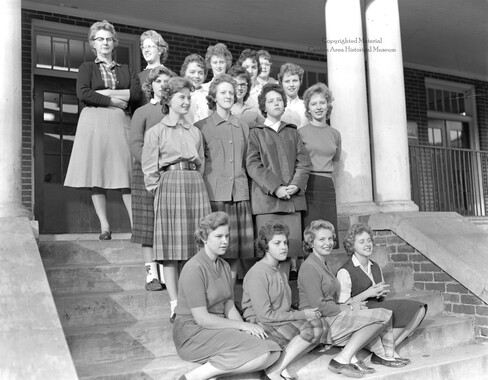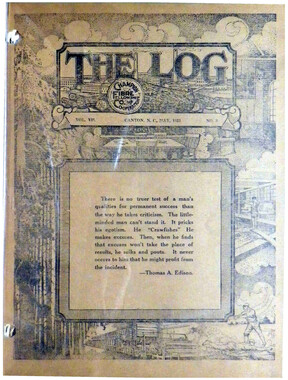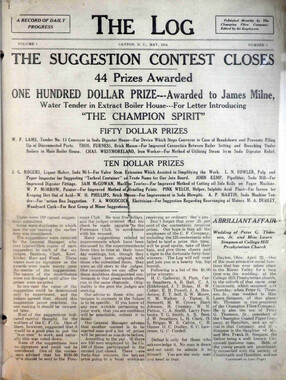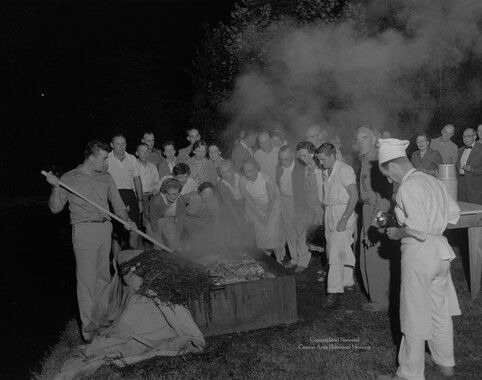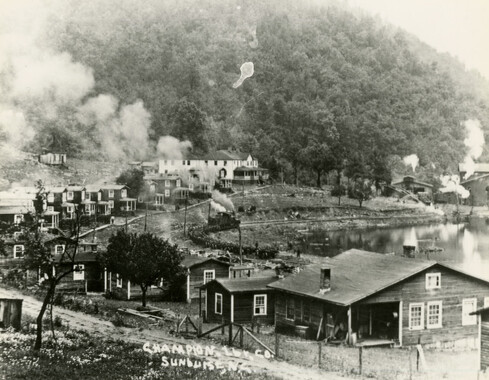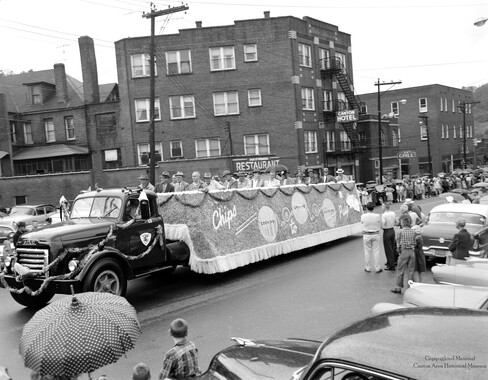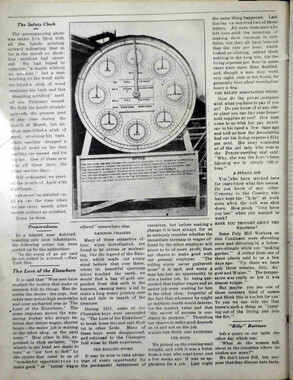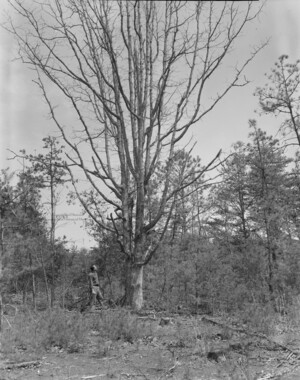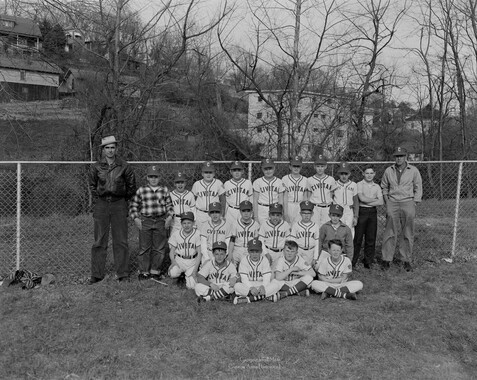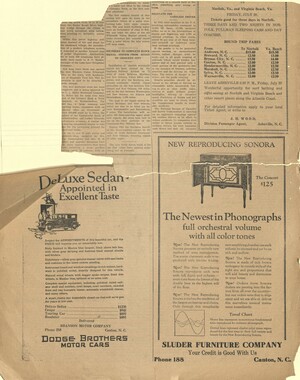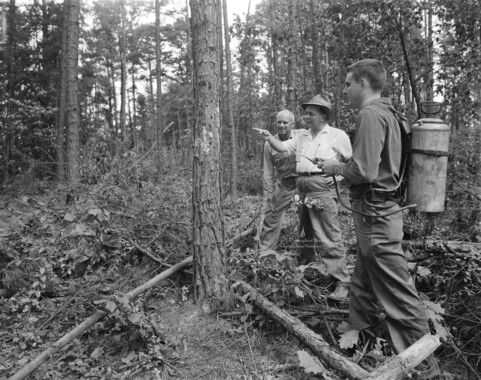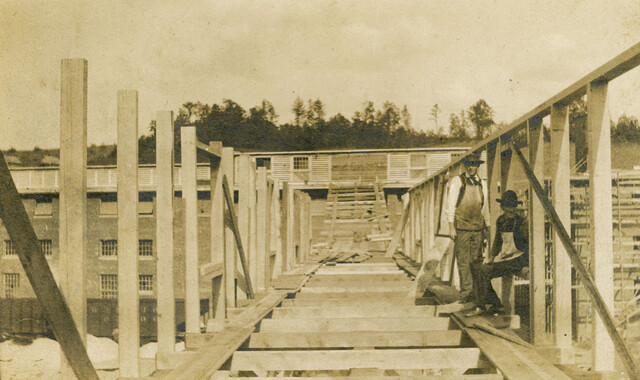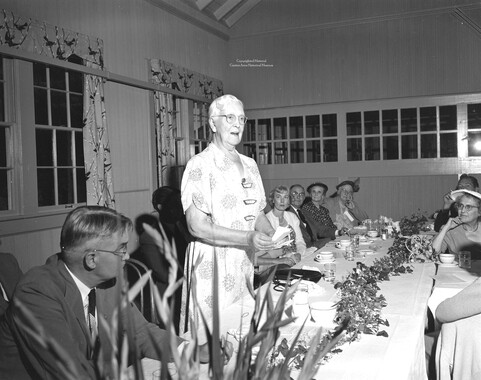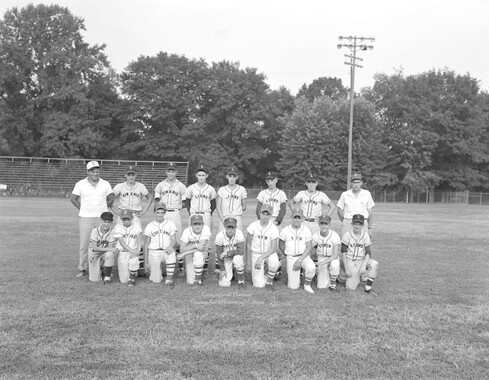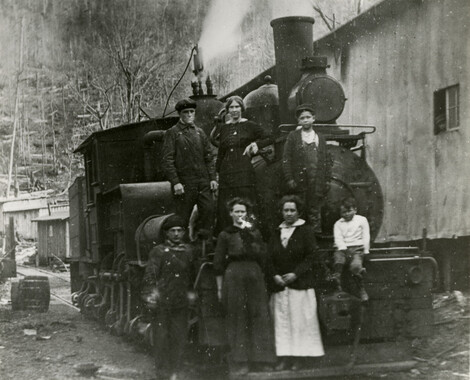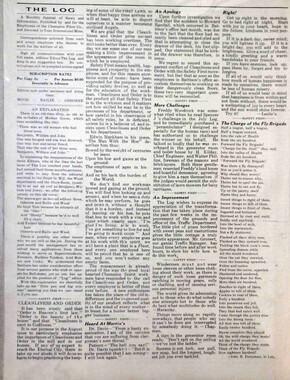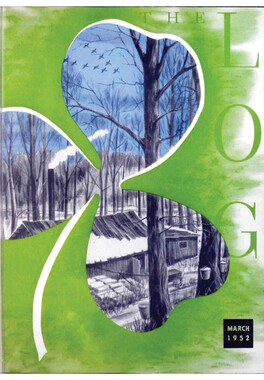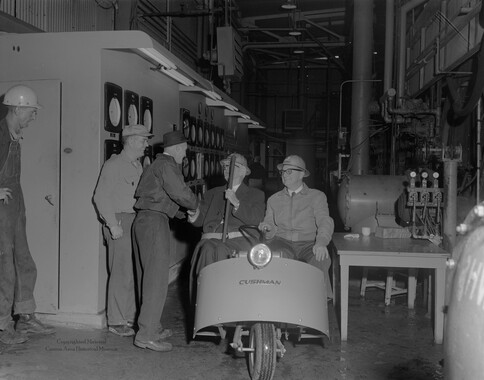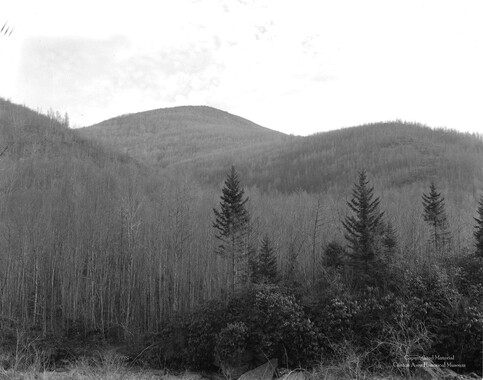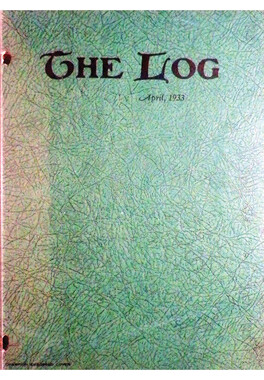Western Carolina University (21)
View all
- Canton Champion Fibre Company (2308)
- Cherokee Traditions (291)
- Civil War in Southern Appalachia (165)
- Craft Revival (1942)
- George Masa Collection (137)
- Great Smoky Mountains - A Park for America (3080)
- Highlights from Western Carolina University (422)
- Horace Kephart (973)
- Journeys Through Jackson (159)
- LGBTQIA+ Archive of Jackson County (89)
- Oral Histories of Western North Carolina (318)
- Picturing Appalachia (6617)
- Stories of Mountain Folk (413)
- Travel Western North Carolina (153)
- Western Carolina University Fine Art Museum Vitreograph Collection (129)
- Western Carolina University Herbarium (92)
- Western Carolina University: Making Memories (738)
- Western Carolina University Publications (2491)
- Western Carolina University Restricted Electronic Theses and Dissertations (146)
- Western North Carolina Regional Maps (71)
- World War II in Southern Appalachia (131)
University of North Carolina Asheville (6)
View all
- Allanstand Cottage Industries (62)
- Appalachian National Park Association (53)
- Bennett, Kelly, 1890-1974 (1463)
- Berry, Walter (76)
- Brasstown Carvers (40)
- Carver, George Washington, 1864?-1943 (26)
- Cathey, Joseph, 1803-1874 (1)
- Champion Fibre Company (233)
- Champion Paper and Fibre Company (297)
- Cherokee Indian Fair Association (16)
- Cherokee Language Program (22)
- Crowe, Amanda (40)
- Edmonston, Thomas Benton, 1842-1907 (7)
- Ensley, A. L. (Abraham Lincoln), 1865-1948 (275)
- Fromer, Irving Rhodes, 1913-1994 (70)
- George Butz (BFS 1907) (46)
- Goodrich, Frances Louisa (120)
- Grant, George Alexander, 1891-1964 (96)
- Heard, Marian Gladys (60)
- Kephart, Calvin, 1883-1969 (15)
- Kephart, Horace, 1862-1931 (313)
- Kephart, Laura, 1862-1954 (67)
- Laney, Gideon Thomas, 1889-1976 (439)
- Masa, George, 1881-1933 (61)
- McElhinney, William Julian, 1896-1953 (44)
- Niggli, Josephina, 1910-1983 (10)
- North Carolina Park Commission (105)
- Osborne, Kezia Stradley (9)
- Owens, Samuel Robert, 1918-1995 (11)
- Penland Weavers and Potters (36)
- Roberts, Vivienne (15)
- Roth, Albert, 1890-1974 (142)
- Schenck, Carl Alwin, 1868-1955 (1)
- Sherrill's Photography Studio (2565)
- Southern Highland Handicraft Guild (127)
- Southern Highlanders, Inc. (71)
- Stalcup, Jesse Bryson (46)
- Stearns, I. K. (213)
- Thompson, James Edward, 1880-1976 (226)
- United States. Indian Arts and Crafts Board (130)
- USFS (683)
- Vance, Zebulon Baird, 1830-1894 (1)
- Weaver, Zebulon, 1872-1948 (58)
- Western Carolina College (230)
- Western Carolina Teachers College (282)
- Western Carolina University (2008)
- Western Carolina University. Mountain Heritage Center (18)
- Whitman, Walt, 1819-1892 (10)
- Wilburn, Hiram Coleman, 1880-1967 (73)
- Williams, Isadora (3)
- Cain, Doreyl Ammons (0)
- Crittenden, Lorraine (0)
- Rhodes, Judy (0)
- Smith, Edward Clark (0)
- Appalachian Region, Southern (3032)
- Asheville (N.C.) (1945)
- Avery County (N.C.) (26)
- Blount County (Tenn.) (195)
- Buncombe County (N.C.) (1680)
- Cherokee County (N.C.) (283)
- Clay County (N.C.) (556)
- Graham County (N.C.) (238)
- Great Smoky Mountains National Park (N.C. and Tenn.) (525)
- Haywood County (N.C.) (3573)
- Henderson County (N.C.) (70)
- Jackson County (N.C.) (4925)
- Knox County (Tenn.) (35)
- Knoxville (Tenn.) (13)
- Lake Santeetlah (N.C.) (10)
- Macon County (N.C.) (421)
- Madison County (N.C.) (216)
- McDowell County (N.C.) (39)
- Mitchell County (N.C.) (135)
- Polk County (N.C.) (35)
- Qualla Boundary (982)
- Rutherford County (N.C.) (78)
- Swain County (N.C.) (2185)
- Transylvania County (N.C.) (270)
- Watauga County (N.C.) (12)
- Waynesville (N.C.) (86)
- Yancey County (N.C.) (72)
- Aerial Photographs (3)
- Aerial Views (60)
- Albums (books) (4)
- Articles (1)
- Artifacts (object Genre) (228)
- Bibliographies (1)
- Biography (general Genre) (2)
- Cards (information Artifacts) (38)
- Clippings (information Artifacts) (192)
- Copybooks (instructional Materials) (3)
- Crafts (art Genres) (622)
- Depictions (visual Works) (21)
- Design Drawings (1)
- Digital Moving Image Formats (2)
- Drawings (visual Works) (185)
- Envelopes (101)
- Exhibitions (events) (1)
- Facsimiles (reproductions) (1)
- Fiction (general Genre) (4)
- Financial Records (12)
- Fliers (printed Matter) (67)
- Glass Plate Negatives (381)
- Guidebooks (2)
- Internegatives (10)
- Interviews (823)
- Land Surveys (102)
- Letters (correspondence) (1045)
- Manuscripts (documents) (618)
- Maps (documents) (177)
- Memorandums (25)
- Minutes (administrative Records) (59)
- Negatives (photographs) (6090)
- Newsletters (1290)
- Newspapers (2)
- Notebooks (8)
- Occupation Currency (1)
- Paintings (visual Works) (1)
- Pen And Ink Drawings (1)
- Periodicals (194)
- Personal Narratives (10)
- Photographs (12977)
- Plans (maps) (1)
- Poetry (6)
- Portraits (4568)
- Postcards (329)
- Programs (documents) (181)
- Publications (documents) (2444)
- Questionnaires (65)
- Relief Prints (26)
- Sayings (literary Genre) (1)
- Scrapbooks (282)
- Sheet Music (2)
- Slides (photographs) (402)
- Songs (musical Compositions) (2)
- Sound Recordings (802)
- Specimens (92)
- Speeches (documents) (18)
- Tintypes (photographs) (8)
- Transcripts (329)
- Text Messages (0)
- A.L. Ensley Collection (275)
- Appalachian Industrial School Records (7)
- Appalachian National Park Association Records (336)
- Axley-Meroney Collection (2)
- Bayard Wootten Photograph Collection (20)
- Bethel Rural Community Organization Collection (7)
- Blumer Collection (5)
- C.W. Slagle Collection (20)
- Canton Area Historical Museum (2110)
- Carlos C. Campbell Collection (462)
- Cataloochee History Project (64)
- Cherokee Studies Collection (4)
- Daisy Dame Photograph Album (5)
- Daniel Boone VI Collection (1)
- Doris Ulmann Photograph Collection (112)
- Elizabeth H. Lasley Collection (1)
- Elizabeth Woolworth Szold Fleharty Collection (4)
- Frank Fry Collection (95)
- George Masa Collection (173)
- Gideon Laney Collection (452)
- Hazel Scarborough Collection (2)
- Hiram C. Wilburn Papers (28)
- Historic Photographs Collection (236)
- Horace Kephart Collection (861)
- Humbard Collection (33)
- Hunter and Weaver Families Collection (1)
- I. D. Blumenthal Collection (4)
- Isadora Williams Collection (4)
- Jesse Bryson Stalcup Collection (47)
- Jim Thompson Collection (224)
- John B. Battle Collection (7)
- John C. Campbell Folk School Records (80)
- John Parris Collection (6)
- Judaculla Rock project (2)
- Kelly Bennett Collection (1482)
- Love Family Papers (11)
- Major Wiley Parris Civil War Letters (3)
- Map Collection (12)
- McFee-Misemer Civil War Letters (34)
- Mountain Heritage Center Collection (4)
- Norburn - Robertson - Thomson Families Collection (44)
- Pauline Hood Collection (7)
- Pre-Guild Collection (2)
- Qualla Arts and Crafts Mutual Collection (12)
- R.A. Romanes Collection (681)
- Rosser H. Taylor Collection (1)
- Samuel Robert Owens Collection (94)
- Sara Madison Collection (144)
- Sherrill Studio Photo Collection (2558)
- Smoky Mountains Hiking Club Collection (616)
- Stories of Mountain Folk - Radio Programs (374)
- The Reporter, Western Carolina University (510)
- Venoy and Elizabeth Reed Collection (16)
- WCU Gender and Sexuality Oral History Project (36)
- WCU Mountain Heritage Center Oral Histories (25)
- WCU Oral History Collection - Mountain People, Mountain Lives (71)
- WCU Students Newspapers Collection (1923)
- Western North Carolina Tomorrow Black Oral History Project (69)
- William Williams Stringfield Collection (2)
- Zebulon Weaver Collection (109)
- African Americans (390)
- Appalachian Trail (35)
- Artisans (521)
- Cherokee art (84)
- Cherokee artists -- North Carolina (10)
- Cherokee language (21)
- Cherokee pottery (101)
- Cherokee women (208)
- Church buildings (190)
- Civilian Conservation Corps (U.S.) (111)
- College student newspapers and periodicals (2012)
- Dams (108)
- Dance (1023)
- Education (222)
- Floods (63)
- Folk music (1015)
- Forced removal, 1813-1903 (2)
- Forest conservation (220)
- Forests and forestry (1198)
- Gender nonconformity (4)
- Great Smoky Mountains National Park (N.C. and Tenn.) (181)
- Hunting (47)
- Landscape photography (25)
- Logging (122)
- Maps (83)
- Mines and mineral resources (9)
- North Carolina -- Maps (18)
- Paper industry (38)
- Postcards (255)
- Pottery (135)
- Railroad trains (72)
- Rural electrification -- North Carolina, Western (3)
- School integration -- Southern States (2)
- Segregation -- North Carolina, Western (5)
- Slavery (5)
- Sports (452)
- Storytelling (243)
- Waterfalls -- Great Smoky Mountains (N.C. and Tenn.) (66)
- Weaving -- Appalachian Region, Southern (280)
- Wood-carving -- Appalachian Region, Southern (328)
- World War, 1939-1945 (173)
The Canton Enterprise Volume 13 Number 16
Item
Item’s are ‘child’ level descriptions to ‘parent’ objects, (e.g. one page of a whole book).
-
-
THE ENTERPRISE, CANTON, N. C. MADAM- KINDLY PERMIT US TO INTRODUCE THE UNSURPASSED IDAHO STEEL RANGE Up-to-date in every particular. Lacking in no detail that goes to make np « a STEEL RANGE of the highest class. Constructed in one of the most modern factories where tbe latest machinery and many years of experience co-operate to produce a range that must be just right to stand the test to which each is subjected before being shipped out. We do not hesitate to pronounce it absolutely perfect in construction, operation and finish. Made by the Huenfeld Co. Design- Aii castings are made perfectly smooth and plain; no carving or scroll work to accumulate dirt or grease. Easy to keep clean. Finish-- Extra large oven, full nickel-plated. Nickel- plated extension towel rack. High Warming Closet- Body made of Weilsville polished steel; closet door of Wood's Planished iron. Upper and lower Bands, Brackets, Corner Pieces, Tea Shelves and Register in Pipe, fully nickel-plated. Main Top of Range-- Made in Sectional Cut Top, consisting of four pieces, two short and one long center and lids. All parts interchange. Fire Box— Of sufficient length and depth to insure the best results. All linings extra heavy, with perforated openings to permit of proper circulation of air. No square, sharp corners to collect ashes. Grate- Duplex, which has had such splendid success in the past. Can be used either for Coal or Wood. The most convenient and practical grate on the market. Ash Pit— Extra large and deep with heavy Ash Pan. Draft Registers-- Two draft registers, increasing draft and giving satisfaction even with poor draft. Ovens— On these ranges they are made of one piece, securely braced on both top and bottom, so that they cannot warp Ovens being heavier than body are of sufficient thickness to give long service. They possess an advantage over a cast oven in that they will heat up quicker, making a saving in fuel consumption. Reservoir— , Cast porcelain lined reservoir of large capacity, encased in iron frame. Damper to shut off when baking. Styles and Dimensions-- We have these ranges with or without reservoir and in various sizes—either six or four .cover. Other Features-- Pouch feed or fire-box. Clean out door, for removing soot under oven. Wood extension in fire box. Extra large removable hearth plate. Extra large flues. SOLD ON EASY PAYMENTS. SLUDER FURNITURE CO., CANTON, N. C. Has the Day Come? ~A_day will come when_the only battlefield will be the market open to commerce and the mind opening to new ideas. A day will come when bullets and bombshells will be replaced by votes, by the universal suffrage of~ nations, by the venerable arbitration of a great sovereign senate, which will be to Europe what the parliament is to England, what the diet is to Germany, what the legislative assembly is to France. A day will come when a cannon will be exhibited in public museums, just as an instrument of tcrture is now, and the people will be astonished how such a thing could have been. A day will come when these two immense groups, the United States of America and the United States of Europe, shall be placed in the presence of each other extending the hand of fellowship across the ocean.—Victor Hugo, 1852. LIVC STOCK REDUCING COST IN FEEDING Farm By-Products Can Be Used More Extensively to Reduce Cost of Cattle Rations. (Prepared by the United States Department ot Agriculture.) That It is possible to feed beef cows In the corn belt more economically dicing the wiuter is Shown by a report of United States department of agriculture investigators who mad. a study of winter feeding costs on live repre- -oLilative farms In that section. This reduction In the cost of feeding -is possible without detriment to the cows or calves through lurger use of farm byproducts in the rations. Avokl feeding excessively, avoid costly rations, use more cheap roughages, such as straw and corn stover, feed silage where conditions make it more economical than corn fodder. The first farm used as an example Is in east central Iowa. The breeding herd consisted of a grade bull and 22 grade cows, from which 20 calves were obtained. The cows were given excessive amounts of high-priced feed for both of the years for which records were procured, says the bulletin. They were turned on stalks November 15. Winter feeding began a few days later and lasted until May 1, when the cows were again turned on pasture. During the 165-day interval each cow received the following: Stalks 11-5 acres at $1 an acre. Fodder 2-5 acre, at $35 nn acre. lAxed hay % ton, at $10 a ton. Corn 2 bus. at $0.65 a. bu. As the average yield of corn on this farm was 50 bushels to the acre, and as the best corn was cut for fodder, the cows, considering the corn in the fodder and the additional grain fed, received a total of 22 bushels per head. This is almost a fattening ration. If tho corn had been husked" from the fodder and only the stover fed, there would have been sufficient roughage for the cows. Estimating that three- fourths of a ton of stover was eaten per acre of stalks and that the stover from the fodder fed would go two tons to the acre, and allowing the cows -three bushels of corn each during the winter instead of 22, they would receive the following daily ration; Stover 20.6 pounds Mixed hay ,.... 9.0 pounds Corn 1.0 pound This ration would be sufficient for their needs. By merely eliminating the excessive amount of corn (19 bushels) from the ration a saving of $11.40 could have been made and the feed bill reduced very nearly one-half, or from $24 to $12.60 per cow. Rations on the fifth farm inspected by the investigators are pronounced very satisfactory. This farm (240 acres) is in northeastern Kansas. Seventy acres were in corn, 25 in oats, 25 in wheat, and 100 in pasture. Because of the unusual rainy weather RED CROSS GIFTS $400^09,900; War Council on Retirement An* nounces Cash and Supplie* Contributed. WORKERS WILL "CARRY ON.* Five Big Societies in World Wide Plan*. H. P. Davison Heads International American Red Cross Commission**, Dr. Livingston Farrand Perman*n$ Leader of Peace Organization. , More Fame and Money for Our Apples The apple is the king of fruits in value of crop as well as in estimation of apple lovers. For the apple crop of 1918 a value of $230,000,000 has been estimated, or nearly three-eighths of the value of all fruits. With more orchardists than ever spraying their apple trees and otherwise giving them more careful attention than ever before, this season Haywood county apples ought to be better in quality than ever Therefore with due attention to harvesting and marketing, Haywood county apples, this season, ought to command better prices than ever. Haywood county apples ought to command as good prices as the much-vaunted "fancy" fruit raised in the Pacific coast states. That Haywood apple growers are unable to command "top notch" prices for their fruit, very probably is largely their own fault. Why not organize a Western North Carolina Apple Growers' association, in order that the world may know and enjoy the Western North Carolina apple— the best on God's green earth. Good Roads the Precursor of Prosperity. As sure as "Trade Follows the Flag", so prosperity follows good roads. For good roads are the forerunner—the precursor of prosperity. That the main thoroughfare in Haywood county—according to the present program—is to be considerably improved, is a matter for present congratulation and future hope. One does not need to draw on his imagination to predict that the inauguration of a system of good roads in Haywood county will insure for her an era of prosperity exceeding in magnitude any she has ever known. No need to seek further for an investment that will earn the greatest dividend in a reasonable length of time. Beyond all peradventure good roads is that investment-—safe and sane. And of this good roads movement no classes of men should be more optimistic promoters than the farmers, orchardists and stockmen. QQ0D QUALITIES OF SHEEP And this for many reasons; chiefly because it will make the They Compare Favorably With Other best markets easily accessible to Anima,s V? Eco.n°m_ °'Produ*- A, , , , „ tion—Keep Weeds Down. them and enable them to sell where their offerings will command the best prices. Good roads is one of the three cardinal assets of any community or county. The other two are good churches and good schools. Beef Cattle on Pasture. Washington.—(Special.) Henry ft Davison as chairman issue* lhe followi ing statement on behalf of the Wat Council of the American Red Cross: "To the American People: "The War Council of the American Red Cross appointed by -'resident WnV eon on May 10, 1917, to carry on thar work of the American Red Cross dur*. Ing the war, at their request and by, vote of the Central Conamitlee, ceased. at midnight, February 28. "Immediately the armistice was signed the War Council instituted! studies to determine when the strict** ly war work of the organization would have been sufficiently matured to en*t able the direction of affairs to be resumed by the permanent staff. Henrjj P. Davison, being in Paris when the. armistice was signed, summoned at conference there of the heads of all' the Red Cross Commissions in Europ- to canvass ihe situation. After considering all the factors it was con** eluded to make the transition oU*i March 1. The very fortunate eholc**|! of Dr. Livingston Farrand as the new; chairman of the Central Committee,, and thereby the permanent, chief executive of the Red Cross, makes poss!*» ble the consummation of this plan un-» der tha most favorable conditions. Accounts Audited by War Department^ "Detailed reports to Congress and tt complete audit of Its accounts by th«j War Department will constitute thai final record o{ Red Cross activity __-$ ing the war. Although it has beei$ the rule to make public all expendhr tores when authorllzed and to give deft tailed information relative to all wort* undertaken, the War Council in tnr_>4 ing over its responsibilities to Dr. Far*- rand and his associates desire to _i*r<$ a brief resume of Red Cross war time) activities to the American people, tt* whom the Red Cross belong, and w__s«j| generous contributions have made po$t sihle all that has been accomplished, "During the past nearly twenty-on_| months the American people hav4 given in cash and supplies to thej* American Red Cross more than $400,«t 000.000. No value can be placed upon, the contribuUons of service whlcbi have been given without stint and of*? tentimes at great sacrifice by millions** of our people. "The effort o_ the American Red! Cross in this war has constituted b*«f far the largest voluntary gifts ol money, of hand and heart, ever contributed purely for the relief of htw man suffering. Through the Red Crosl) the heart and spirit of the whole? American people have been mobilized? to take care of our own, to relieve the. misery Incident to the war, and also* to reveal to the world the supreme ideals of our national life. "Everyone who has had any part lufe this war effort of tbe Red Cross is eti«- tltled to etntg-atnlate himself. .Vw thanks from unynie ooold be (iQual ire value to the self satisfaction everyone should feel fit* tho pan taken. Fully 8,000(000 American women have, exerted tftejnse-Ves in Red Cross serv- ice. Has Over 17,000,000 Adult Member*. '•When wo entered the war the; American Bed Cross had about 5O0.0O0- members. Today, as the result of the recent: Christmas membership ft_U Call, there ore upwards ot; l7,0-b,00O , foil paid members mttslde of the metu- i bers of Ihe junior lied Cross. numbering perhaps 9,000,000 »chooJ ehiUlren. additional. "The ct_e_ effort of ihe Red Cross- to care for prevailing in that section tbo oats and wheat for the year in which the record was taken were practically destroyed and the straw was absolutely worth-j d*lriI,*-r the K!0' has been our men in service and to aid our less for feeding. To provide for a lack of hay 15 acres of millet and four of sorghum were grown. The herd consisted of a hull and 15 grade cows, from which 15 calve-* were obtained. The cows were turned on army and navy wherever the Red Cross may be called on to assist. Aa to this phase of the work burgeon <!en- eral Ireland of the rj. S Army recently said: 'The Red Cross has been an , I enterprise as vast as the war itself. From the beginning it has done those there until spring. They received approximately three acres of stalks, one ton of millet hay, and one-third of a ton of sorghum fodder each. Valuing the millet at $_.50 a ton and the sorghum at ?4 u ton, the winter feed cost per cow was .-58.20. The cows were carried tnrough the entire year for a net cost of $_o\65. I Song Thrown In. Eggs that are cheap sometimes do when you put them to your ear.—Boston Transcript. Sheep can be made profitable on high-priced land, it Is said, as Hrltish experience shows. They eompivo favorably with other animals in economy of production. They require a minimum of expensive Cone-ritrat-d things which tbe Army Medical Corpt** wanted done, but coal, not do itself.' "The Red Cross endeavor in France* has naturally been upon an exceptionally large scale where service .bag been rendered to the American Army and t.o the French Arms nn_ th« French people as well, the latter particularly daring the trying period* when the Allied World was waiting for the American ,Anny to arise int force* and power. Hospital emergency; service for our army in France _,_- greatly dimhiisbed. but the Red Cross* Is still being called upon tor service*, upon a larue scale in the great has* hospitals, where thousands of American sick and wounded are still receiv-. ing attention. At these hospitals the* Red Cross supplies huts and facilities, for the amusement and recreation of tbe men as they become convalescent. feeds. They exceed the larger an).- Our Army of Occupation In Germsn-jr mals in the rate of maturity; lambs was followed with Medical units* pre- can be made ready for market al from four to six months. They make ;><■-• Bible the economical 'ind fttller B8i- labor. They are of ussis; mce lag the farms free iron; __♦*_> farm is usually a * pared to render the same emergency, aid and «npp1y service which was the> prlmr.r*? business of the Ited Cross during hostilities. The Army Canteen service along the lines of travel hut
Object
Object’s are ‘parent’ level descriptions to ‘children’ items, (e.g. a book with pages).
-
The Canton Enterprise (19??–1971) was published in Canton, North Carolina by the Canton Publishing Company. Its preceding title was The Canton Observer (circa 1900-), and succeeding title was The Enterprise (1971-1996).
-
